MITSUBISHI ASX 2018 Owner's Manual (in English)
Manufacturer: MITSUBISHI, Model Year: 2018, Model line: ASX, Model: MITSUBISHI ASX 2018Pages: 514, PDF Size: 34.89 MB
Page 361 of 514
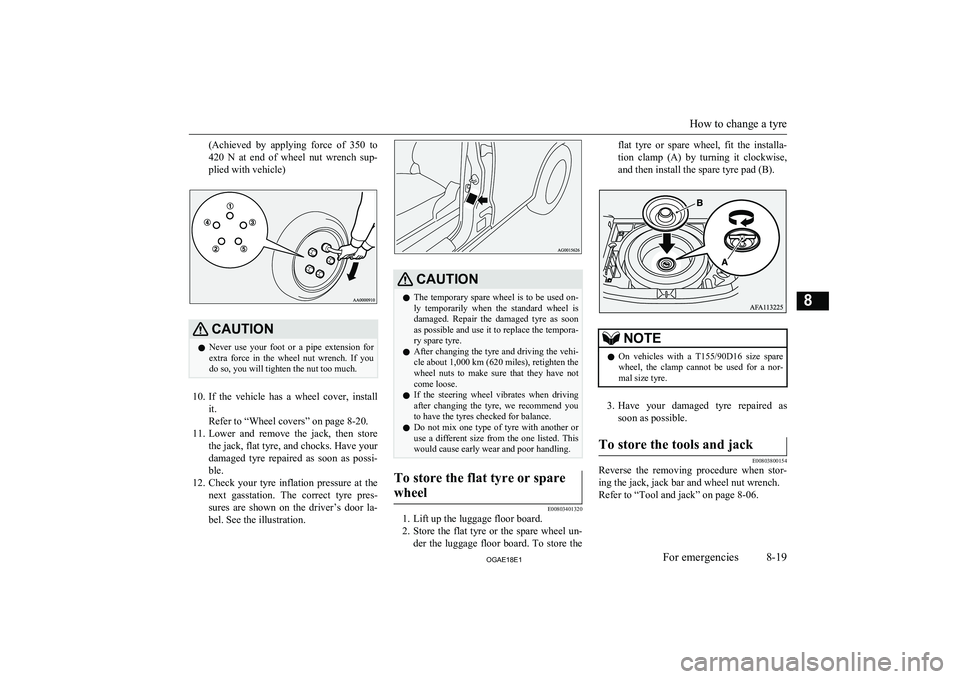
(Achieved by applying force of 350 to
420 N at end of wheel nut wrench sup- plied with vehicle)CAUTIONl Never use your foot or a pipe extension for
extra force in the wheel nut wrench. If you
do so, you will tighten the nut too much.
10. If the vehicle has a wheel cover, install
it.
Refer to “Wheel covers” on page 8-20.
11. Lower and remove the jack, then store
the jack, flat tyre, and chocks. Have your
damaged tyre repaired as soon as possi- ble.
12. Check your tyre inflation pressure at the
next gasstation. The correct tyre pres-
sures are shown on the driver’s door la- bel. See the illustration.
CAUTIONl The temporary spare wheel is to be used on-
ly temporarily when the standard wheel isdamaged. Repair the damaged tyre as soon
as possible and use it to replace the tempora- ry spare tyre.
l After changing the tyre and driving the vehi-
cle about 1,000 km (620 miles), retighten the
wheel nuts to make sure that they have not come loose.
l If the steering wheel vibrates when driving
after changing the tyre, we recommend you to have the tyres checked for balance.
l Do not mix one type of tyre with another or
use a different size from the one listed. This would cause early wear and poor handling.To store the flat tyre or spare
wheel
E00803401320
1. Lift up the luggage floor board.
2. Store the flat tyre or the spare wheel un-
der the luggage floor board. To store the
flat tyre or spare wheel, fit the installa-
tion clamp (A) by turning it clockwise,
and then install the spare tyre pad (B).NOTEl On vehicles with a
T155/90D16 size spare
wheel, the clamp cannot be used for a nor-
mal size tyre.
3. Have your damaged tyre repaired as
soon as possible.
To store the tools and jack
E00803800154
Reverse the removing procedure when stor-
ing the jack, jack bar and wheel nut wrench.
Refer to “Tool and jack” on page 8-06.
How to change a tyre
8-19OGAE18E1For emergencies8
Page 362 of 514
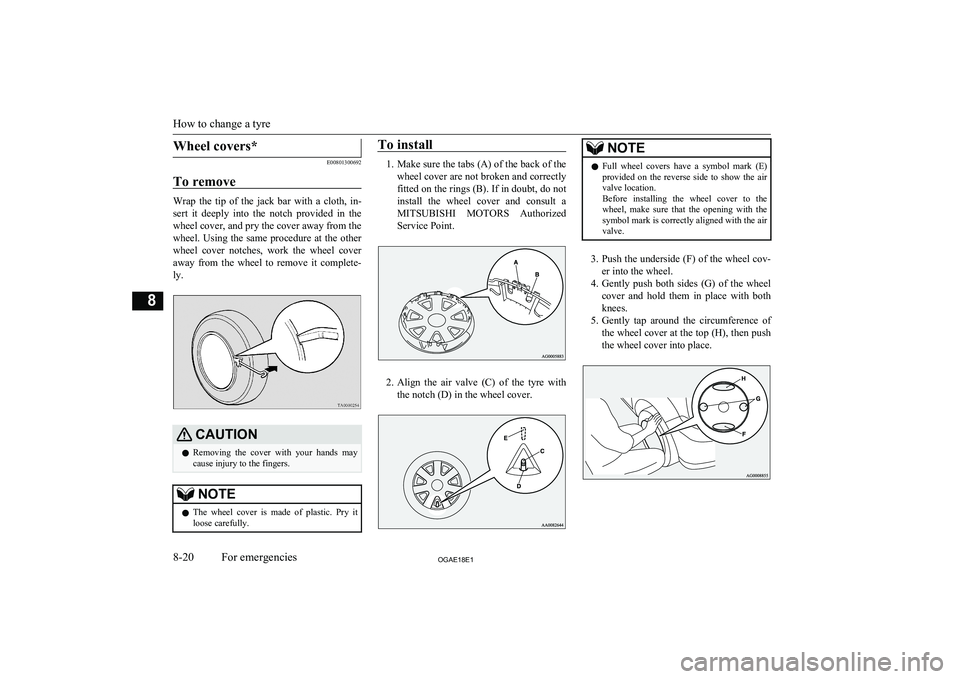
Wheel covers*
E00801300692
To remove
Wrap the tip of the jack bar with a cloth, in- sert it deeply into the notch provided in the
wheel cover, and pry the cover away from the
wheel. Using the same procedure at the other
wheel cover notches, work the wheel cover away from the wheel to remove it complete-
ly.
CAUTIONl Removing the cover with your hands may
cause injury to the fingers.NOTEl The wheel cover is made of plastic. Pry it
loose carefully.To install
1. Make sure the tabs (A) of the back of the
wheel cover are not broken and correctly fitted on the rings (B). If in doubt, do not install the wheel cover and consult aMITSUBISHI MOTORS Authorized
Service Point.
2. Align the air valve (C) of the tyre with
the notch (D) in the wheel cover.
NOTEl Full wheel covers have a symbol mark (E)
provided on the reverse side to show the air
valve location.
Before installing the wheel cover to the wheel, make sure that the opening with the
symbol mark is correctly aligned with the air valve.
3. Push the underside (F) of the wheel cov-
er into the wheel.
4. Gently push both sides (G) of the wheel
cover and hold them in place with both knees.
5. Gently tap around the circumference of
the wheel cover at the top (H), then push
the wheel cover into place.
How to change a tyre
8-20OGAE18E1For emergencies8
Page 363 of 514
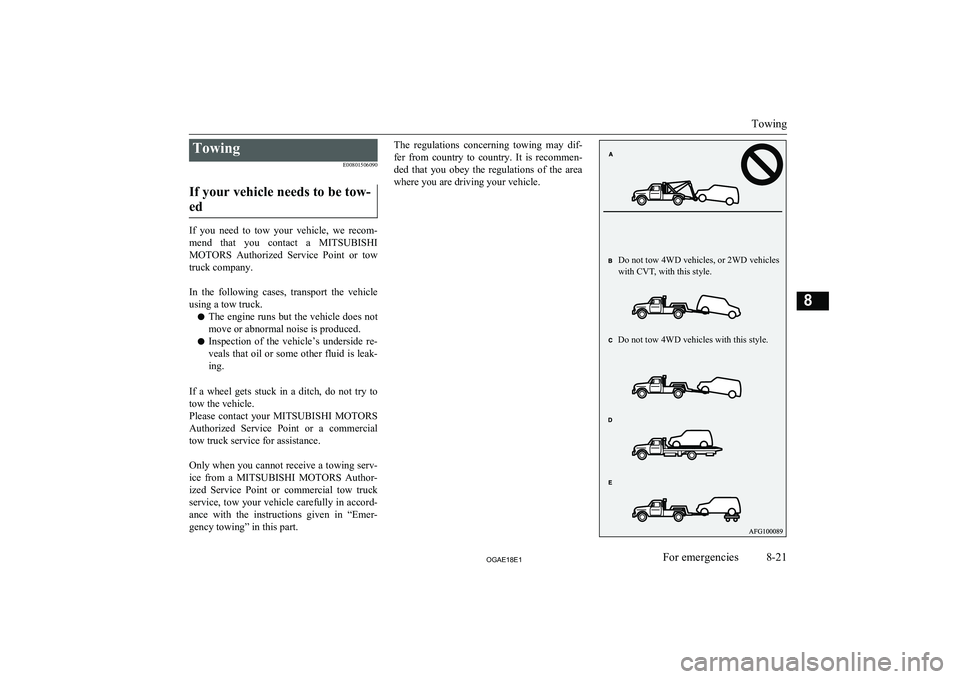
TowingE00801506090
If your vehicle needs to be tow- ed
If you need to tow your vehicle, we recom- mend that you contact a MITSUBISHI
MOTORS Authorized Service Point or tow
truck company.
In the following cases, transport the vehicle
using a tow truck.
l The engine runs but the vehicle does not
move or abnormal noise is produced.
l Inspection of the vehicle’s underside re-
veals that oil or some other fluid is leak- ing.
If a wheel gets stuck in a ditch, do not try to
tow the vehicle.
Please contact your MITSUBISHI MOTORS
Authorized Service Point or a commercial
tow truck service for assistance.
Only when you cannot receive a towing serv-
ice from a MITSUBISHI MOTORS Author-
ized Service Point or commercial tow truck service, tow your vehicle carefully in accord-
ance with the instructions given in “Emer- gency towing” in this part.
The regulations concerning towing may dif-
fer from country to country. It is recommen-
ded that you obey the regulations of the area where you are driving your vehicle.
Towing
8-21OGAE18E1For emergencies8Do not tow 4WD vehicles, or 2WD vehicles
with CVT, with this style.
Do not tow 4WD vehicles with this style.
Page 364 of 514
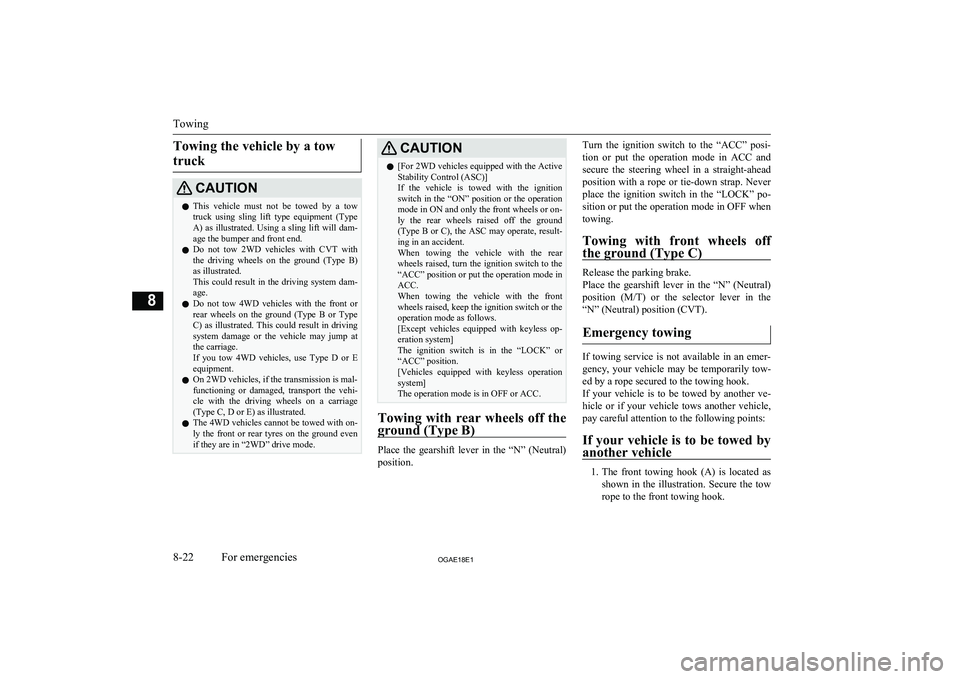
Towing the vehicle by a towtruckCAUTIONl This vehicle must not be towed by a tow
truck using sling lift type equipment (Type A) as illustrated. Using a sling lift will dam-age the bumper and front end.
l Do not tow 2WD vehicles with CVT with
the driving wheels on the ground (Type B) as illustrated.
This could result in the driving system dam- age.
l Do not tow 4WD vehicles with the front or
rear wheels on the ground (Type B or Type C) as illustrated. This could result in drivingsystem damage or the vehicle may jump at
the carriage.
If you tow 4WD vehicles, use Type D or E
equipment.
l On 2WD vehicles, if the transmission is mal-
functioning or damaged, transport the vehi- cle with the driving wheels on a carriage (Type C, D or E) as illustrated.
l The 4WD vehicles cannot be towed with on-
ly the front or rear tyres on the ground even
if they are in “2WD” drive mode.CAUTIONl [For 2WD vehicles equipped with the Active
Stability Control (ASC)]
If the vehicle is towed with the ignition switch in the “ON” position or the operation
mode in ON and only the front wheels or on- ly the rear wheels raised off the ground (Type B or C), the ASC may operate, result-
ing in an accident.
When towing the vehicle with the rear wheels raised, turn the ignition switch to the
“ACC” position or put the operation mode in ACC.
When towing the vehicle with the front wheels raised, keep the ignition switch or the
operation mode as follows.
[Except vehicles equipped with keyless op- eration system]
The ignition switch is in the “LOCK” or
“ACC” position.
[Vehicles equipped with keyless operation system]
The operation mode is in OFF or ACC.
Towing with rear wheels off the
ground (Type B)
Place the gearshift lever in the “N” (Neutral)
position.
Turn the ignition switch to the “ACC” posi-
tion or put the operation mode in ACC and
secure the steering wheel in a straight-ahead position with a rope or tie-down strap. Neverplace the ignition switch in the “LOCK” po-
sition or put the operation mode in OFF when towing.
Towing with front wheels off the ground (Type C)
Release the parking brake.
Place the gearshift lever in the “N” (Neutral) position ( M/T) or the selector lever in the
“N” (Neutral) position (CVT).
Emergency towing
If towing service is not available in an emer-
gency, your vehicle may be temporarily tow- ed by a rope secured to the towing hook.
If your vehicle is to be towed by another ve- hicle or if your vehicle tows another vehicle,
pay careful attention to the following points:
If your vehicle is to be towed by
another vehicle
1. The front towing hook (A) is located as
shown in the illustration. Secure the tow
rope to the front towing hook.
Towing
8-22OGAE18E1For emergencies8
Page 365 of 514
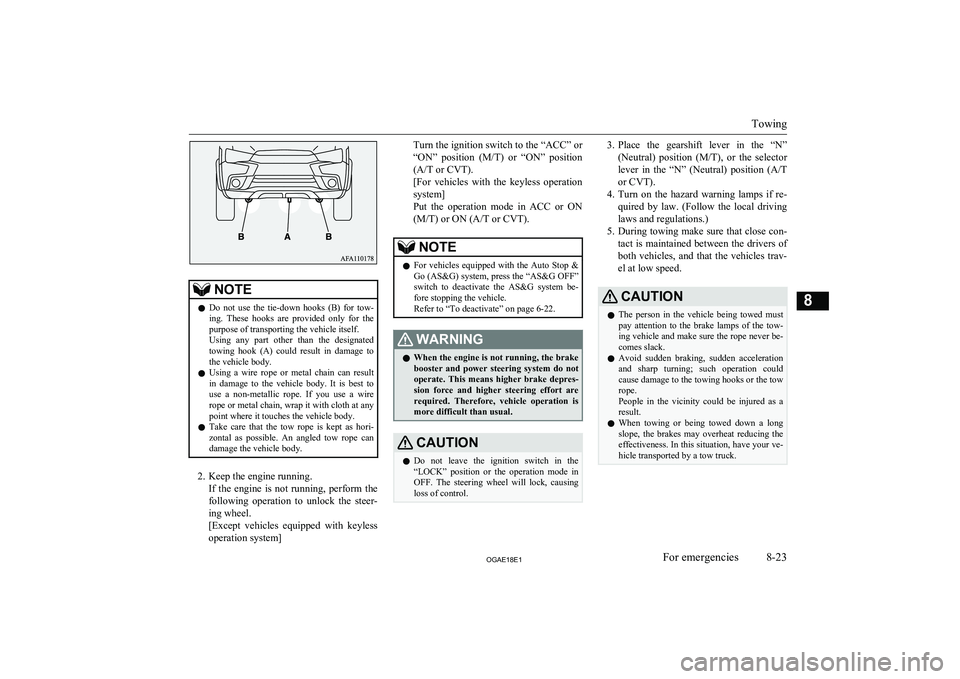
NOTElDo not use the tie-down hooks (B) for tow-
ing. These hooks are provided only for thepurpose of transporting the vehicle itself.
Using any part other than the designated
towing hook (A) could result in damage to
the vehicle body.
l Using a wire rope or metal chain can result
in damage to the vehicle body. It is best to
use a non-metallic rope. If you use a wire
rope or metal chain, wrap it with cloth at any point where it touches the vehicle body.
l Take care that the tow rope is kept as hori-
zontal as possible. An angled tow rope can damage the vehicle body.
2. Keep the engine running.
If the engine is not running, perform the
following operation to unlock the steer- ing wheel.
[Except vehicles equipped with keyless
operation system]
Turn the ignition switch to the “ACC” or
“ON” position ( M/T) or “ON” position
(A/T or CVT).
[For vehicles with the keyless operation system]
Put the operation mode in ACC or ON
(M/T) or ON (A/T or CVT).NOTEl For vehicles equipped with the Auto Stop &
Go (AS&G) system, press the “AS&G OFF”switch to deactivate the AS&G system be-
fore stopping the vehicle.
Refer to “To deactivate” on page 6-22.WARNINGl When the engine is not running, the brake
booster and power steering system do not
operate. This means higher brake depres- sion force and higher steering effort arerequired. Therefore, vehicle operation is more difficult than usual.CAUTIONl Do not leave the ignition switch in the
“LOCK” position or the operation mode in
OFF. The steering wheel will lock, causing loss of control.3. Place the gearshift lever in the “N”
(Neutral) position ( M/T), or the selector
lever in the “N” (Neutral) position ( A/T
or CVT).
4. Turn on the hazard warning lamps if re-
quired by law. (Follow the local driving
laws and regulations.)
5. During towing make sure that close con-
tact is maintained between the drivers of
both vehicles, and that the vehicles trav- el at low speed.CAUTIONl The person in the vehicle being towed must
pay attention to the brake lamps of the tow- ing vehicle and make sure the rope never be-
comes slack.
l Avoid sudden braking, sudden acceleration
and sharp turning; such operation could
cause damage to the towing hooks or the tow
rope.
People in the vicinity could be injured as a
result.
l When towing or being towed down a long
slope, the brakes may overheat reducing the effectiveness. In this situation, have your ve-hicle transported by a tow truck.
Towing
8-23OGAE18E1For emergencies8
Page 366 of 514
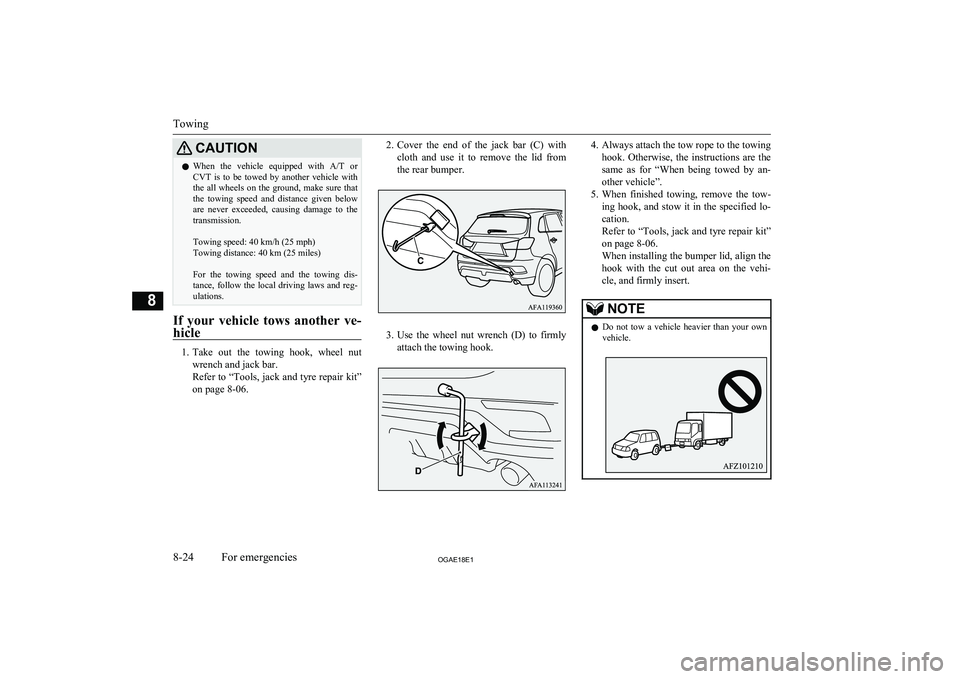
CAUTIONlWhen the vehicle equipped with
A/T or
CVT is to be towed by another vehicle with
the all wheels on the ground, make sure that the towing speed and distance given below
are never exceeded, causing damage to the
transmission.
Towing speed: 40 km/h (25 mph)
Towing distance: 40 km (25 miles)
For the towing speed and the towing dis- tance, follow the local driving laws and reg- ulations.
If your vehicle tows another ve-
hicle
1. Take out the towing hook, wheel nut
wrench and jack bar.
Refer to “Tools, jack and tyre repair kit”
on page 8-06.
2. Cover the end of the jack bar (C) with
cloth and use it to remove the lid from
the rear bumper.
3. Use the wheel nut wrench (D) to firmly
attach the towing hook.
4. Always attach the tow rope to the towing
hook. Otherwise, the instructions are the
same as for “When being towed by an- other vehicle”.
5. When finished towing, remove the tow-
ing hook, and stow it in the specified lo- cation.
Refer to “Tools, jack and tyre repair kit”
on page 8-06.
When installing the bumper lid, align the
hook with the cut out area on the vehi-
cle, and firmly insert.NOTEl Do not tow a vehicle heavier than your own
vehicle.
Towing
8-24OGAE18E1For emergencies8
Page 367 of 514
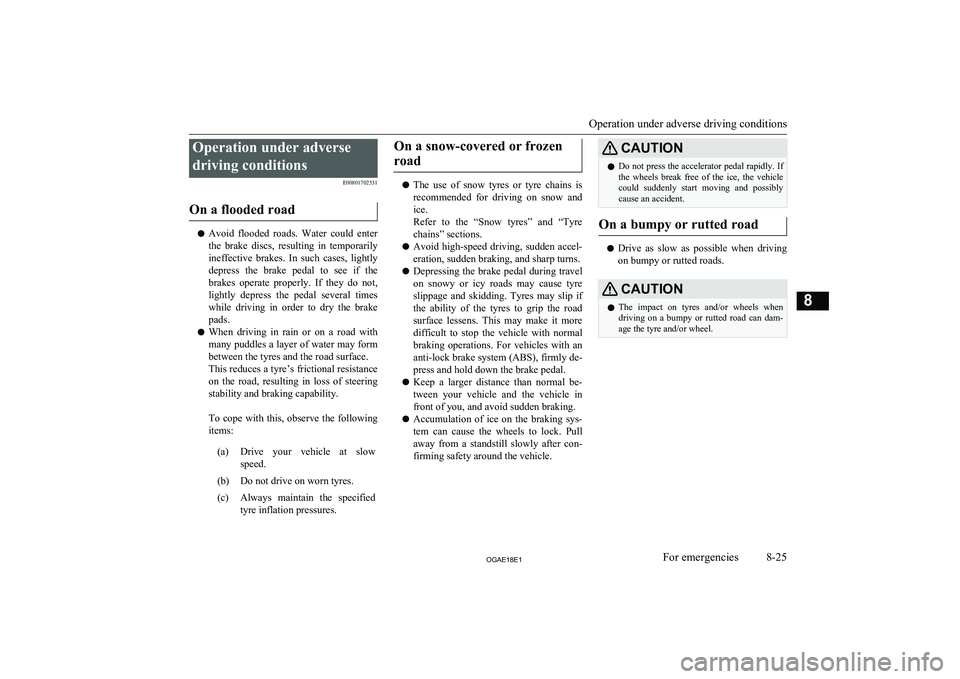
Operation under adversedriving conditions E00801702531
On a flooded road
l Avoid flooded roads. Water could enter
the brake discs, resulting in temporarily ineffective brakes. In such cases, lightly
depress the brake pedal to see if the
brakes operate properly. If they do not,
lightly depress the pedal several times while driving in order to dry the brake
pads.
l When driving in rain or on a road with
many puddles a layer of water may form
between the tyres and the road surface.
This reduces a tyre’s frictional resistance on the road, resulting in loss of steering
stability and braking capability.
To cope with this, observe the following items:
(a)Drive your vehicle at slow
speed. (b)Do not drive on worn tyres. (c)Always maintain the specified tyre inflation pressures.On a snow-covered or frozen
road
l The use of snow tyres or tyre chains is
recommended for driving on snow and
ice.
Refer to the “Snow tyres” and “Tyre chains” sections.
l Avoid high-speed driving, sudden accel-
eration, sudden braking, and sharp turns.
l Depressing the brake pedal during travel
on snowy or icy roads may cause tyre
slippage and skidding. Tyres may slip if the ability of the tyres to grip the roadsurface lessens. This may make it more
difficult to stop the vehicle with normal
braking operations. For vehicles with an anti-lock brake system (ABS), firmly de-
press and hold down the brake pedal.
l Keep a larger distance than normal be-
tween your vehicle and the vehicle in front of you, and avoid sudden braking.
l Accumulation of ice on the braking sys-
tem can cause the wheels to lock. Pull away from a standstill slowly after con- firming safety around the vehicle.
CAUTIONl Do not press the accelerator pedal rapidly. If
the wheels break free of the ice, the vehicle
could suddenly start moving and possibly cause an accident.
On a bumpy or rutted road
l Drive as slow as possible when driving
on bumpy or rutted roads.
CAUTIONl The impact on tyres and/or wheels when
driving on a bumpy or rutted road can dam-
age the tyre and/or wheel.
Operation under adverse driving conditions
8-25OGAE18E1For emergencies8
Page 368 of 514
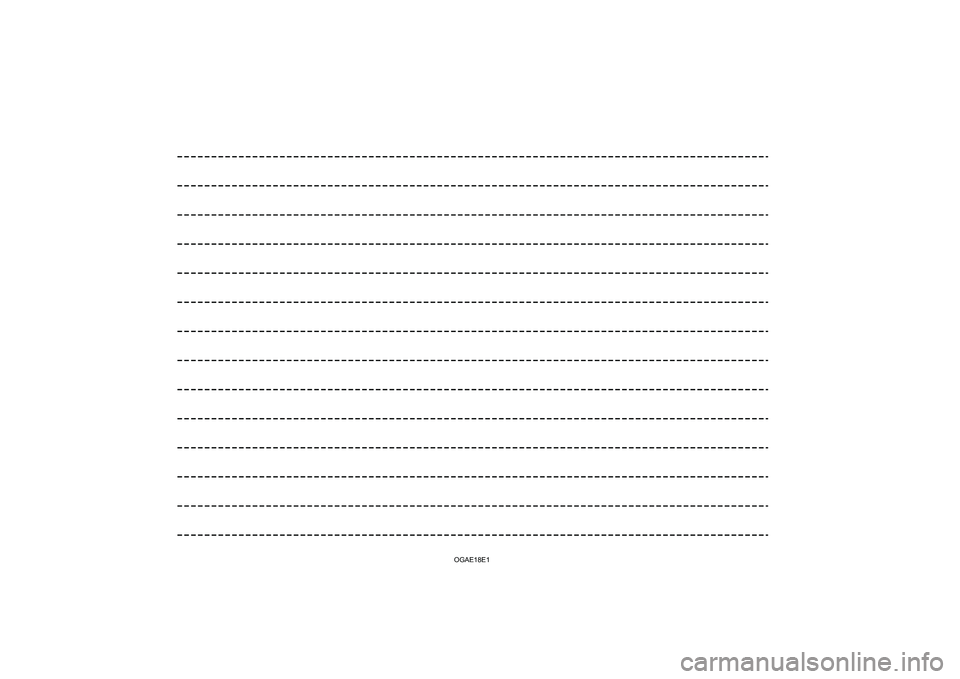
OGAE18E1
Page 369 of 514
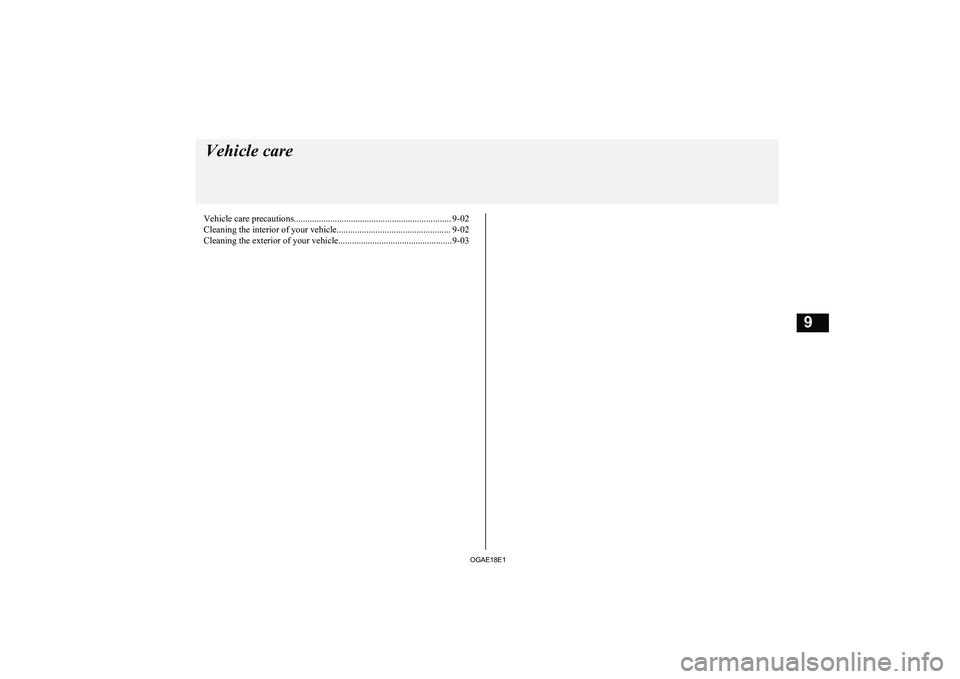
Vehicle care precautions..................................................................... 9-02
Cleaning the interior of your vehicle.................................................. 9-02 Cleaning the exterior of your vehicle..................................................9-03Vehicle care
OGAE18E19
Page 370 of 514
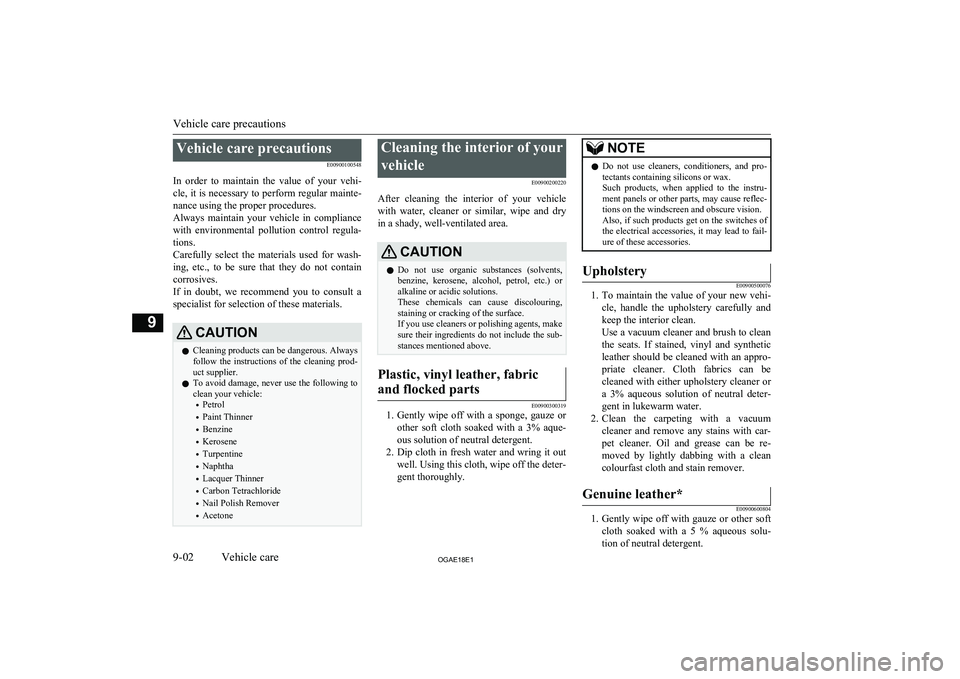
Vehicle care precautionsE00900100548
In order to maintain the value of your vehi- cle, it is necessary to perform regular mainte- nance using the proper procedures.
Always maintain your vehicle in compliance
with environmental pollution control regula- tions.
Carefully select the materials used for wash- ing, etc., to be sure that they do not contain
corrosives.
If in doubt, we recommend you to consult a specialist for selection of these materials.CAUTIONl Cleaning products can be dangerous. Always
follow the instructions of the cleaning prod- uct supplier.
l To avoid damage, never use the following to
clean your vehicle:
• Petrol
• Paint Thinner
• Benzine
• Kerosene
• Turpentine
• Naphtha
• Lacquer Thinner
• Carbon Tetrachloride
• Nail Polish Remover
• AcetoneCleaning the interior of your
vehicle E00900200220
After cleaning the interior of your vehicle with water, cleaner or similar, wipe and dry
in a shady, well-ventilated area.CAUTIONl Do not use organic substances (solvents,
benzine, kerosene, alcohol, petrol, etc.) or
alkaline or acidic solutions.
These chemicals can cause discolouring, staining or cracking of the surface.
If you use cleaners or polishing agents, make
sure their ingredients do not include the sub- stances mentioned above.Plastic, vinyl leather, fabric
and flocked parts
E00900300319
1. Gently wipe off with a sponge, gauze or
other soft cloth soaked with a 3% aque-
ous solution of neutral detergent.
2. Dip cloth in fresh water and wring it out
well. Using this cloth, wipe off the deter-
gent thoroughly.
NOTEl Do not use cleaners, conditioners, and pro-
tectants containing silicons or wax.
Such products, when applied to the instru- ment panels or other parts, may cause reflec-
tions on the windscreen and obscure vision.
Also, if such products get on the switches of
the electrical accessories, it may lead to fail-
ure of these accessories.Upholstery
E00900500076
1. To maintain the value of your new vehi-
cle, handle the upholstery carefully and
keep the interior clean.
Use a vacuum cleaner and brush to clean
the seats. If stained, vinyl and synthetic leather should be cleaned with an appro- priate cleaner. Cloth fabrics can be cleaned with either upholstery cleaner or
a 3% aqueous solution of neutral deter-
gent in lukewarm water.
2. Clean the carpeting with a vacuum
cleaner and remove any stains with car- pet cleaner. Oil and grease can be re- moved by lightly dabbing with a cleancolourfast cloth and stain remover.
Genuine leather*
E00900600804
1. Gently wipe off with gauze or other soft
cloth soaked with a 5 % aqueous solu-tion of neutral detergent.
Vehicle care precautions
9-02OGAE18E1Vehicle care9